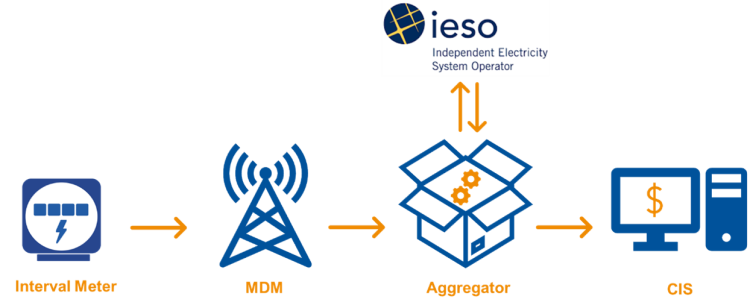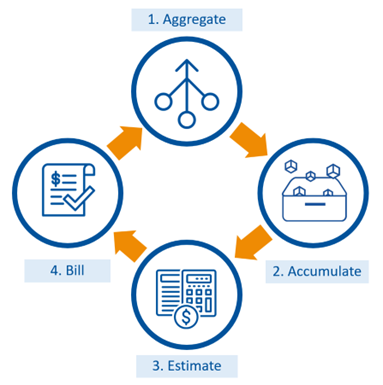
A Custom Solution to a Unique Meter Communication Challenge
Business Challenge
When Ontario’s electricity regulator, the Independent Electricity System Operator (IESO), instructed utilities in Ontario to replace MV-90 meters with interval meters for certain large clients with significant power consumption, a small municipally owned utility encountered a challenge. Due to the nature of large industrial buildings, consistent smart meter radio frequency (RF) communication can be a problem, and missing intervals are common. The new interval meters – known as MIST meters (Meter Inside Settlement Timeframe) – report usage within a defined settlement period, and since interval meters must be billed within that settlement period, these intervals must be calculated for billing to proceed. Complicating matters is the fact that the interval meters report load profile data for four channels: accumulated kilowatt hours (kWh), kilowatt usage for the hour (kW), accumulated kilovolt ampere hours (kVAh), and kilovolt ampere usage for the hours (kVA). The values in the load profile must be consistent – if one or more values is missing or cannot be validated, intervention is required.
Util-Assist has been helping utilities with similar problems for dozens of years. Our SyncAssist service is designed to simplify advanced metering infrastructure (AMI) operations—SyncAssist operators resolve meter exceptions to ensure that bill-ready data is delivered accurately and on time. Each day, AMI systems generate synchronization exceptions, data collection exceptions, stale meters, tampers, invalid time flags, usage spikes, swapped meters, and more. And if there are delays, the exceptions can quickly pile up and affect revenue. As the utility was already a SyncAssist client, Util-Assist was asked to develop a solution for handling MIST meter exceptions.
Util-Assist’s Role
The SyncAssist team has developed rigorous processes, refined over more than a dozen years, to streamline exception management across multiple AMI and meter data management (MDM) solutions. The team also helps resolve unique meter data management problems, such as this one.
Over the course of several weeks, Util-Assist’s team conducted a root cause analysis to determine the reason for missing intervals from MIST meters, which turned out to be poor communications in industrial settings. Since the client’s meter-to-cash billing cycle involved several systems, the solution required collaboration and cooperation across three vendors.
- Interval meters report data to an MDM system.
- The MDM forwards meter data to a data aggregator.
- The aggregator connects to the IESO to retrieve the Hourly Ontario Energy Pricing Reports and applies those prices to the aggregated hourly consumption for each meter.
- From the data aggregator, the validated meter information and pricing goes to the client’s customer information system (CIS), which bills the customer.

On behalf of the utility, SyncAssist operators engaged and worked closely with the utility’s system vendors to develop the process and ruleset that would enable the utility to bill its interval metered customers. The resulting process consisted of four steps.

- Aggregate: Because the interval meters report at 15-minute intervals while the Ontario settlement period is one hour, the decision was made to create a “cloned” set of meters in the MDM. Each hour, four 15-minute interval reports are aggregated into a single interval for each meter.
- Accumulate: Each day, 24 of these intervals are added to a file, which in turn is forwarded to a vendor that manages and aggregates multi-meter billing for accounts. The vendor generates a daily “gap report” of missing interval reads, which it sends to the SyncAssist team.
- Estimate: SyncAssist operators use the gap report to resolve the missing data reads in the MDM. There are two methods used to supply the missing information:
- Most missing intervals can be estimated with some accuracy using a combination of historical load profile for the meter, plus the meter reads on either side of the gap. A technique called “linear interpolation” is applied to create the appropriate missing intervals.
- Cases that cannot be resolved via this technique, such as a register read on one of the four channels that fails validation, must instead be resolved manually by our analysts. The analysts directly access the client’s back-end database and run a query to identify the root cause of the missing information. Once the error is identified, the analysts access the AMI system directly to overwrite the “bad” read with a valid one. If there is not a valid read from the AMI, the analysts generate an estimated read to fill the gap.
- Bill: Once the missing information has been estimated, the revised file is sent to the data aggregator, allowing the rates to be applied so billing can proceed.
Results
The extension of our SyncAssist engagement at the utility to include MIST meters has been a success. We resolve an average of 27 MIST meter exceptions per day, which adds up: in a single year, Util-Assist’s SyncAssist team solved approximately 6,480 exceptions for the client. The steady cadence of SyncAssist activities keeps the meter-to-cash cycle flowing, maintaining revenue for the utility and accurate billing for their clients.
Util-Assist has been delivering SyncAssist to utility clients for over a dozen years; our advanced technical skill set, deep knowledge of data flows and processes, and team of experienced analysts make us the ideal choice to help utilities optimize AMI operations.
